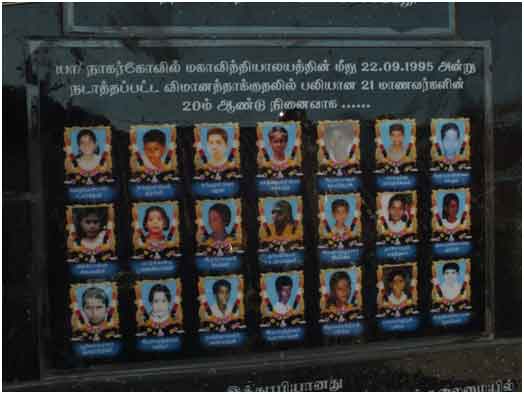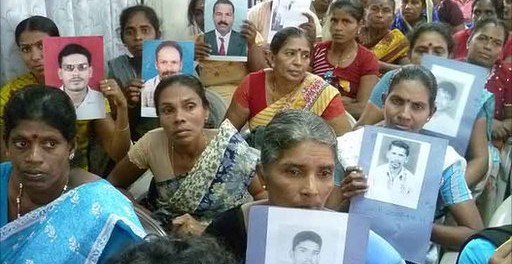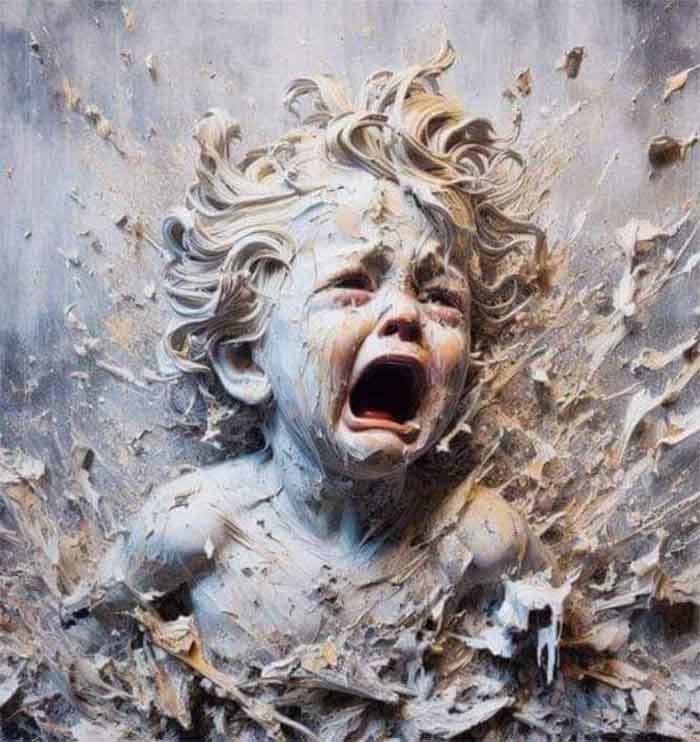
On September 22, 1995, a SLAF aircraft bombed the Nagarkovil Maha Vidyalayam schoolyard crammed with 750 children on their lunch break, killing more than 30 – of whom 12 were six or seven-year-olds – and injuring 150 others. The overall death toll from the raids reached 71. The bombing occurred just hours after the Sri Lankan government imposed press censorship on the reporting of military events.
“The bombing of the school happened at 12.50 p.m. during the school’s lunch break when several of the school children were gathered under a shade tree in the school compound. 25 school going children were among 40 Tamil civilians killed on the spot. Twelve were six and seven year olds. Nearly 200 others were injured, most of them students in the same school. Elsewhere in the area, 15 other civilians were also killed in the course of the same bombing raids. The scene of the attack was visited by the International Red Cross. Pieces of human flesh were strewn around the area including the tree branches, making identification impossible.The total death toll later increased to 71.
Earlier, on the same day, Pucara bombers targeted Manalkadu and Katkovalam in the Vadamardchi area killing six persons. A small Catholic church was also damaged in the bombing. In another incident in the early hours of the same day, intense shelling from the Palali army camp killed seven members of the same family including four children of varying ages. The shelling began at 3.00 a.m. and continued until 7.00 a.m.
The 1996 HRW annual country report described “a major offensive on the Jaffna peninsula” by the Sri Lankan government which began on September 22, and which included curbs on war-related reporting by both the domestic and international press. “Among the first stories to be subjected to these censorship requirements were reports that on September 21 and 22, heavy shelling and aerial attacks by government forces on the northern Jaffna region had killed some seventy civilians, including many school children.” Human Rights Watch also cited a Reuters report from September 23 that the army had denied the incident and that the story had been “subjected to military censors, who deleted quotes from civilians on the reported deaths of twenty children
According to University Teachers for Human Rights (UTHR), a Jaffna-based organization, the staff of Nagarkovil Government School noticed bomber activity by the Sri Lanka Air Force around the school the morning of Friday, September 22, 1995. Several children who had come out of school had sheltered under a tree, waiting for the bombers to leave. About 12:45 pm a bomb fell near the tree, instantly killing 39 and injuring others. Some people injured by the bombing later died from their wounds.
Two surgeons from Medecins Sans Frontierers (MSF) worked through the night at Point Pedro’s Manthikai hospital carrying out 22 amputations – in four cases removing both legs. Ten of the amputees were under 12.
“The scene of the attack was visited by the International Red Cross and pieces of human flesh were found strewn around the area including the tree branches,” said International Educational Development, an NGO on the United Nations Economic and Social Council Roster.
International condemnation
“I condemn in the strongest terms this attack on a school where innocent children were killed. Whatever the political situation in a country, nothing justifies attacks on educational institutions,” Director-General of UNESCO, Fredrico Mayor, said.
In Australia, Ted Grace, an Australian federal parliamentarian and Chairman of the Caucus Committee on Foreign Affairs, Defence & Trade called for public condemnation of Sri Lanka in a speech in the Australian Parliament on 27 September.
“Our Government which is deeply committed to upholding human rights should publicly condemn such crimes committed against humanity and should be alarmed at the Sri Lankan Government’s determination to carry out such acts with impunity,” he said.
International Educational Development expressed its grief and shock at the attack, saying “the actions of the Sri Lanka armed forces, coupled with the economic blockade imposed on the Tamil homeland, are a clear contravention of the Geneva Convention relating to non international armed conflicts.”
The names and ages of the 26 students who died in the SLAF attack are:
Tharmalingam Usanthini (13), Markandu Nagalogini (10), Thamotharam Sakunthala (12), R. Regina (11), Pologarajah Thushanthini (14), Ravindran Amirtha (10), Balachandran Rajitha (10), Navaratnasamy Umathevy (12), Suntharalingam Palani (15), Suntharalingam Tharsini (14), Kugasaravanamalai Tharsini (13), Rajeev Gandhi Venu (11), Krishnagopal Thavaseelan (13), Rajaratnam Kavitha (10), Nagamutthu Senthilvel (15), Alfonse Amalaviji(14),Mahalingam Sanmugavadivelan(16),R. Sumithra(10),K. Methini(14, Navamany Mithura(14), Sellam(15),Ragavan(16),Thangarasa Vasanthakumar(06), Mylvaganam Gananathan(14), Ranjithkumar Rajitha(11).
Kumarathasan Rasingam – Secretary, Tamil Canadian Elders for Human Rights Org.















































